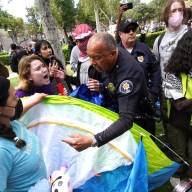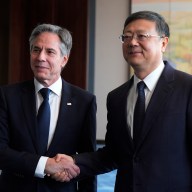 Sorry we didn’t ask Harrison Ford any “Star Wars” questions (but not that sorry).
Sorry we didn’t ask Harrison Ford any “Star Wars” questions (but not that sorry).
Credit: Getty Images
Harrison Ford isn’t as terrifying to talk to as you might have heard. Over the years he’s gotten a reputation as gruff, pissy, overly succinct, transparently wishing he was somewhere else. This isn’t completely untrue — as long as your questions aren’t too dumb, and especially if they aren’t about “Star Wars” or Indiana Jones. Now 71, he’s relaxed into supporting or at least co-lead roles, which he continues as one of the villains in the tech world thriller “Paranoia.” And though we were too scared/uninterested to ask him about his involvement in the next “Star Wars” entry, we were brave enough to ask about some of his earlier work — like the Jacques Demy film he almost starred in long, long before he was a star back in 1969.
This is another film about technology, about which you’ve voiced negative opinions in the past.
I’m just not a huge fan of so much connectivity. I use it for research and to take messages. I don’t much love it. It’s a love-hate relationship. Or it’s a like-hate relationship.
“Paranoia” touches on some important issues: income gaps, greed, health insurance. Were these what drew you to the film?
No. I was drawn to the character and the relationships, and the manipulation of an ambitious young person by two powerful businessmen. The cat and mouse of the whole thing is what interested me — and the opportunity to play a character different from what I’ve played lately. I haven’t played the bad guy for a very long time.
He’s not just a stock villain, though. He actually seems, for a time, genuine.
That’s what I liked about it. He’s a manipulator. What interested me was the complexity. There’s not only corporate greed and perfidy; there’s a young man who has a bit of the blind ambition issue. So he’s ripe for manipulation.
Did you do anything differently to get you in a different mindset?
I shaved my head. I shaved my hairline back and dyed my hair for “42.” There was no way it was going to grow out in time to be useful. So I presented myself to Paramount people with a shaved head, much to their surprise.
What’s fun about playing a villain?
It’s just something different. It’s something unexpected for the audience. I’m just happy to have fun.
You’ve been doing a lot more supporting and co-lead roles lately. Is that a way of getting rid of the burden of having to be the lead and carry a whole movie on your lonesome?
Yeah, it is. It’s great fun. You have the ability when people complain to say, “Hey, I just work here. Take it up with the boss.”
Is doing more character work a return to your earlier days?
No, it was no fun at all in my early days. I was playing smaller parts because I hadn’t become certified at that point, the way you are when you have some success. Then people start to be a little bit more interested in what you think and what you have to say.
It seems you had some wiggle-room in Francis Ford Coppola’s “The Conversation,” back in 1974.
Well, he was very generous, very collaborative in those days.
When you’re working with younger actors, do you tend to give them advice?
[Chuckles] No, I don’t give advice. It’s neither appropriate nor very nice to walk onto a set telling people how to conduct their lives, their careers. So, no. I hope I’m collegial and friendly, but I don’t offer advice to people. I thought they were great. I had a great time working with Liam and Gary, the younger actor. Everybody’s younger than I am.
There’s still some actors older than you.
How many?
Back in 1969, well before you were known, you almost wound up playing the lead in French filmmaker Jacques Demy’s first and only American film, “Model Shop.”
[Laughs] Jacques was a lovely guy. He wanted to make this movie in Los Angeles. When you drove down Santa Monica Boulevard, you’d see these “Live Nude Girls” signs for all kinds of weird stuff that was going on. He imagined a movie about a young man and a woman who worked in one of these places. We were friends and we researched it a bit. Jacques wanted me to star in it. And the studio, who was paying me $150 a week — and had all the respect for me that $150 a week implies — cast the film with Gary Lockwood while Jacques was up in San Francisco scouting locations. That was a shock to him. For me it was just another indication that I was hanging my hat on the wrong peg.
You and Jacques and his wife, Agnes Varda, stayed in touch, though. Varda has put you in some of her documentaries.
I still see Agnes anytime I got to Paris. She’s just exactly the same. I believe that last time I saw her she had purple hair. She’s great. I love her.
Did you ever try to work together again?
Jacques ran away from Hollywood, and I very shortly after that had a bit of luck. Before that I had started doing carpentry.
I read you first met George Lucas while you were building his bookshelves.
No. That’s a wrong story. The truth is Dean Tavalouris, who was Francis Ford Coppola’s art director, had had an elaborate entrance made for Francis’ offices. He couldn’t find a carpenter to install it. He asked me if I could do it, because he was really stuck. I said I’d do it at night, ‘cause I didn’t want to confuse people between my two careers. The last night I was working on it, by myself, finishing up, and George Lucas walked in for the first of the “Star Wars” interviews with Richard Dreyfuss. We had earlier been told by our agents that George was going to see anybody for “American Grafitti.” That was the first time I’d seen George in a very long time. Very shortly thereafter he asked me to read with all the other actors. So I read them, did screen tests. Then later they asked me if I wanted to play the part. So that’s the real story.
















